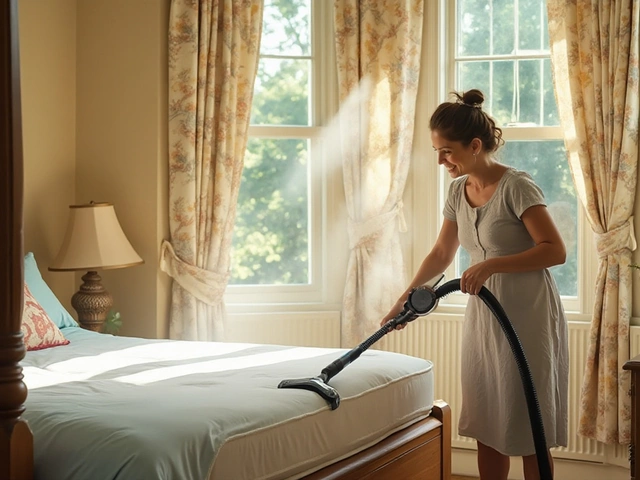Ever stared at a cleaning quote and felt that ache in your wallet? Turns out, deep cleaning isn’t just a simple scrub-and-go. Prices can be shocking, and it’s not just about charging for some extra elbow grease.
Deep cleaning digs way deeper than your typical tidy-up. We’re talking moving furniture, getting under appliances, scrubbing grout, and tackling grime most folks never see. This takes special tools, strong cleaning agents, and usually a whole team of pros working for hours, not minutes.
If you’re wondering whether you really need all that — and whether you’re overpaying — you’re not alone. Plenty of people question the cost, and for good reason. Don’t worry, though. There are ways to spot a fair price, and ways to make sure you’re not stuck paying for stuff you don’t need.
- What Is 'Deep Cleaning' Anyway?
- Why the Supplies Aren't Cheap
- Time: The Hidden Price Tag
- Tricks Cleaning Companies Use to Set Prices
- How to Tell If You're Getting Ripped Off
- Smart Ways to Cut Deep Cleaning Costs
What Is 'Deep Cleaning' Anyway?
Think of deep cleaning as the superhero version of regular cleaning. This is not your usual quick sweep and mop. Deep cleaning means cleaning every corner — stuff that people usually skip, like behind the fridge, under the couch, and even inside the oven.
Professional deep cleaning goes after grime, dust, and gunk that’s been building up for months or even years. It covers all those places that never see the light of day during a normal clean-up. The idea? Everything gets a reset, so your place feels like new.
Here’s what typically gets tackled:
- Scrubbing tile grout till it changes color
- Wiping down baseboards, light switches, and door frames
- Moving big furniture to clean behind and under it
- Cleaning inside appliances — ovens, microwaves, and fridge shelves
- Dusting vents, ceiling fans, and even blinds one by one
- Sanitizing bathrooms beyond the basic wipe
Some companies follow a strict checklist — you’ll see every room gets deep attention, not just a surface wipe. They’ll use beefier cleaning products, sometimes industrial-strength, and special equipment like steam cleaners or high-powered vacs.
How does this compare to standard cleaning? Here’s a quick look:
| Type | What Gets Cleaned | How Often |
|---|---|---|
| Standard Cleaning | Floors, surfaces, bathrooms, light tidying | Weekly or biweekly |
| Deep Cleaning | Baseboards, behind furniture, appliances, grout, detailed dusting | Every 3-6 months, or before big events |
So, when you pay big for a deep cleaning, remember, it’s supposed to mean your whole home gets an intense overhaul — not a quick once-over. That’s exactly why the bill stings so much more.
Why the Supplies Aren't Cheap
When people hear the price for deep cleaning, most assume it’s just the cost of labor. Actually, a big chunk of what you pay goes straight to supplies and equipment. Deep cleaning isn’t about one bottle of all-purpose spray and a torn-up sponge. Pros haul in industrial-strength vacuums, special mops, carpet steamers, and stiff brushes that cost a ton more than what you have at home.
Many cleaning jobs need hospital-grade disinfectants, powerful degreasers, and scrubbing agents. These aren’t just things you find at the grocery store, and they don’t come cheap. For example, a gallon of pro-grade floor cleaner can run up to $40, compared to $8 for a regular household bottle. Some jobs call for fume-hooded chemicals to fight mold or built-up minerals, which brings the price up even more.
Here’s a quick look at what professional cleaning supplies can cost:
| Item | Typical Price |
|---|---|
| Commercial vacuum | $200 - $600 |
| Pro-grade disinfectant | $30 - $50/gallon |
| Carpet steam cleaner | $250 - $900 |
| HEPA filters | $50 - $100 |
| Specialty grout cleaner | $20 - $60/bottle |
Plus, crews burn through sponges, mop heads, gloves, and microfiber cloths at a crazy rate. If you’re ever curious, just ask how much equipment one crew goes through in a week. You’ll see why these costs get rolled into your cleaning services bill.
If you’re trying to save some cash, try picking up your own supplies—just make sure they’re up to the same standard, or you might be stuck with leftover gunk that the pros would’ve tackled easily.
Time: The Hidden Price Tag
Here’s what most people don’t realize about deep cleaning: time is the biggest cost driver. It’s not just about scrubbing a little longer—it’s a whole detailed operation. A standard home deep clean can run anywhere from 4 to 10 hours, depending on the size and what needs to be done.
Even in a regular three-bedroom house, a professional cleaning crew can spend all day on things you barely think about. This includes pulling out appliances, getting behind toilets, and dealing with hard-water stains that take major muscle to remove. Every extra bathroom or pet in the house adds more time, which means a bigger bill.
Most professional cleaning companies price their jobs by the hour, with at least two cleaners on site. Here’s a quick look at typical time estimates for common deep clean tasks:
| Task | Time (Minutes Per Room) |
|---|---|
| Bathroom deep clean | 60–90 |
| Kitchen scrub | 90–120 |
| Dusting vents & baseboards | 20–30 |
| Cleaning windows (inside) | 15–25 |
Multiply those numbers by every room, and that’s a big reason cleaning services costs rack up fast.
The other thing people miss? Most companies pay their cleaners hourly, and quality control means no rushing through jobs. If you want a super-fast clean, you’ll sacrifice quality—plus, those stubborn stains won’t budge in a hurry. So, next time you see that four-figure quote, remember: all those labor hours don’t come cheap.
If you’d rather not pay for every nook and cranny, consider picking just a few “problem” areas for a targeted deep clean. You’ll cut the hours (and cost) way down and still get the main benefit of deep cleaning.

Tricks Cleaning Companies Use to Set Prices
Ever wonder why two deep cleaning quotes can be hundreds of bucks apart? It’s not just what gets cleaned — it’s how companies stack on the price. Cleaning businesses have a few classic moves up their sleeves, and you’ve probably seen a few in action.
First up: upselling. You call for a standard service, but suddenly, there’s a checklist of "extras" — fridge cleaning, oven scrubbing, baseboard detailing. Each add-on means more cash. According to HomeAdvisor, the average deep clean starts at $200 but can soar past $400 once all the extras get tacked on.
Some companies price services by square footage, but others break it down by number of rooms or even specific chores. This can confuse folks trying to compare quotes. A 2,000-square-foot home can look affordable until you realize that’s just for floors and walls — and the inside of your microwave? That’s extra.
Watch for minimum charges, too. Companies often set a base price no matter how small the job. That little studio apartment? It might cost almost as much as a big house because their cleaners still have to show up and break out the same gear. There's also the “recurring service discount” trick — where one-time deep cleaning is pricier, nudging you into booking repeat cleanings for a lower rate, even if you don’t really need them.
And then there are surprise fees: special products for allergies, travel charges outside a set zone, or "heavily soiled" surcharges. Most people don’t expect these until the cleaner points out stains or pet hair and hands over a new invoice. Like one cleaning company owner said:
“Folks are surprised when a deep clean costs double a regular one, but it’s not just time — it’s all the little extras that add up. If you want a sparkling oven, it’s not included unless you ask.”
Here’s a quick snapshot of common pricing extras you might see:
| Service Add-on | Typical Extra Cost |
|---|---|
| Fridge cleaning | $25–$50 |
| Oven cleaning | $25–$50 |
| Baseboard scrubbing | $30–$60 |
| Inside windows | $40–$80 |
If you ever feel overwhelmed by an itemized quote, ask for a plain-language breakdown. Make sure you’re not being charged for work you didn’t approve. Compare a few quotes, and look up reviews that mention hidden charges. The more you know about how cleaning companies price their work, the better you can control what you pay — and for what services.
How to Tell If You're Getting Ripped Off
The world of deep cleaning is full of wild price swings. Some pros will quote you double what others do. It can be hard to tell what’s fair. So, how do you spot the warning signs?
First, check the details of the quote. Real pros give itemized estimates. It should break down each service (like cleaning baseboards, scrubbing the oven, or shampooing carpets) with an actual price listed for every task. If you just get a vague total or phrases like “all inclusive,” be suspicious. Hidden fees often turn up after the cleaning starts. According to Consumer Reports, "the more specific the quote, the less likely you'll get hit with surprise charges later.”
Keep an eye out for fancy-sounding package names. Stuff like “platinum clean” or “executive deep service” often means a jacked-up price for stuff you may not need. The basic dirt-busting is what matters most.
- Compare at least three cleaning services before picking one. If someone’s pricing is way off from the other two, ask why.
- Ask them what cleaning products and tools they use. Name brands and high-end equipment may justify a higher quote, but only if they can explain why it makes a difference.
- Read real reviews—on Google, Yelp, and even Reddit. Notice if any complaints mention hidden charges or rushed jobs.
If your quote has extra charges for things that should be part of a deep cleaning—like dusting trim, cleaning the bathroom sink, or vacuuming floors—that’s a red flag. You shouldn’t see separate line items for every minor task.
| Typical Deep Cleaning Cost (USD) | What's Included |
|---|---|
| $200 - $400 | Whole house, windows, baseboards, oven, deep bathroom/kitchen clean |
| Extra $50 - $100 | Pet hair removal, inside fridge, carpet shampooing |
If you spot anything much higher than these ballpark ranges, or the cleaner can’t say exactly what you’re paying for, don’t be afraid to walk away. Lots of folks don’t realize just how much wiggle room there is in cleaning costs.
One last tip: never pay the full amount up front. A small deposit is normal, but anything more should raise some suspicion. And remember, legit cleaners are happy to answer questions, show proof of insurance, and give you a written plan of the job. If they hesitate on any of that, it’s your cue to keep shopping.
Smart Ways to Cut Deep Cleaning Costs
When it comes to deep cleaning, you don't always have to pay top dollar. There are plenty of hacks and strategies to keep your bill from ballooning—even if you’re not ready to do everything yourself.
- Tackle Basic Cleaning Before Pros Arrive: Wipe down counters, declutter, and vacuum ahead of time. The less a cleaning team has to do, the less time they’ll spend (and charge you for).
- Only Book What You Really Need: Focus on rooms that matter most, like kitchens and bathrooms. Skip unused guest rooms or storage areas if they don’t actually need it.
- Compare Quotes: Don’t just go with the first company you find. Ask for detailed estimates from at least three professional cleaning services. Some will give discounts for referrals or first-time bookings.
- Bundle Services: Many professional cleaning companies offer deals if you combine a deep cleaning with regular upkeep visits. Ask if it’s cheaper to bundle and spread the work over a couple of appointments.
- Ask About Supplies: Some companies charge extra for their own cleaning products. If you supply your own or have allergy concerns, you might save a chunk of cash.
- Negotiate: Don’t be shy about asking for a better rate, especially if you have a straightforward job or are booking multiple cleanings. Lots of companies have wiggle room built in.
Costs can vary depending on the area and square footage, but here’s a rough idea of average deep cleaning prices per home size in the US:
| Square Footage | Average Price Range ($) |
|---|---|
| 800-1,000 | 150 - 220 |
| 1,500-2,000 | 250 - 400 |
| 2,500+ | 400 - 600+ |
One powerful trick: If the work is spread over multiple visits, some cleaning crews might offer a ‘maintenance’ rate, which is much cheaper per visit than repeating a full deep cleaning every time.
Finally, don’t pay for add-ons you don’t need—like interior windows or oven cleaning—unless it’s really necessary. Review every line on the quote and ask what’s essential versus what’s just extra. A quick chat can trim your bill fast and help you avoid paying for the same work twice.




